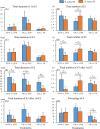Changes in Bemisia tabaci feeding behaviors caused directly and indirectly by cucurbit chlorotic yellows virus
- PMID: 31438971
- PMCID: PMC6704720
- DOI: 10.1186/s12985-019-1215-8
Changes in Bemisia tabaci feeding behaviors caused directly and indirectly by cucurbit chlorotic yellows virus
Abstract
Background: Plant viruses can affect vector's behaviors in order to enhance viral transmission. Cucurbit chlorotic yellows virus (CCYV) (genus Crinivirus) is an emergent RNA plant virus and is transmitted specifically by biotypes B and Q of tobacco whitefly, Bemisia tabaci (Gennadius), in a semipersistent manner.
Methods: We used the electrical penetration graph (EPG) to investigate the effect of CCYV on the feeding behaviors of B. tabaci biotypes B and Q.
Results: CCYV could affect, both directly and indirectly, the feeding behaviors of B. tabaci to various degrees, depending on biotypes and sexes of the insect. CCYV showed stronger direct effects on biotype Q than on biotype B in terms of increased non-phloem probing and phloem salivation. CCYV increased non-phloem probing and phloem salivation more on females than on males of biotype Q, and increased phloem salivation more on females than on males of biotype B. CCYV had stronger indirect effects, via virus-infested plants, on biotype B than on biotype Q by enhancing phloem sap ingestion and feeding bouts. CCYV increased non-phloem probing and feeding bouts more on males than on females of biotype B, and decreased phloem sap ingestion more on males than on females on biotype Q indirectly.
Conclusions: The results clearly indicated that CCYV affects the feeding behaviors of B. tabaci, which may lead to increased ability of the B. tabaci for CCYV transmission.
Keywords: Bemisia tabaci; Cucurbit chlorotic yellows virus; Electrical penetration graph; Feeding behaviors; Semipersistent virus.
Conflict of interest statement
The authors declare that they have no competing interests.
Figures


References
-
- Fereres A, Moreno A. Behavioural aspects influencing plant virus transmission by homopteran insects. Virus Res. 2009;141(2):158–168. - PubMed
-
- Mauck K, Bosqueperez NA, Eigenbrode SD, De Moraes CM, Mescher MC. Transmission mechanisms shape pathogen effects on host-vector interactions: evidence from plant viruses. Funct Ecol. 2012;26(5):1162–1175.
-
- Ng JCK, Zhou JS. Insect vector-plant virus interactions associated with non-circulative, semi-persistent transmission: current perspectives and future challenges. Curr Opin Virol. 2015;15:48–55. - PubMed
-
- Whitfield AE, Falk BW, Rotenberg D. Insect vector-mediated transmission of plant viruses. Virology. 2015;479:278–289. - PubMed
-
- Jahan SMH, Lee GS, Lee S, Lee KY. Upregulation of probing- and feeding-related behavioural frequencies in Bemisia tabaci upon acquisition of Tomato yellow leaf curl virus. Pest Manag Sci. 2014;70(10):1497–1502. - PubMed
Publication types
MeSH terms
LinkOut - more resources
Full Text Sources
Miscellaneous

